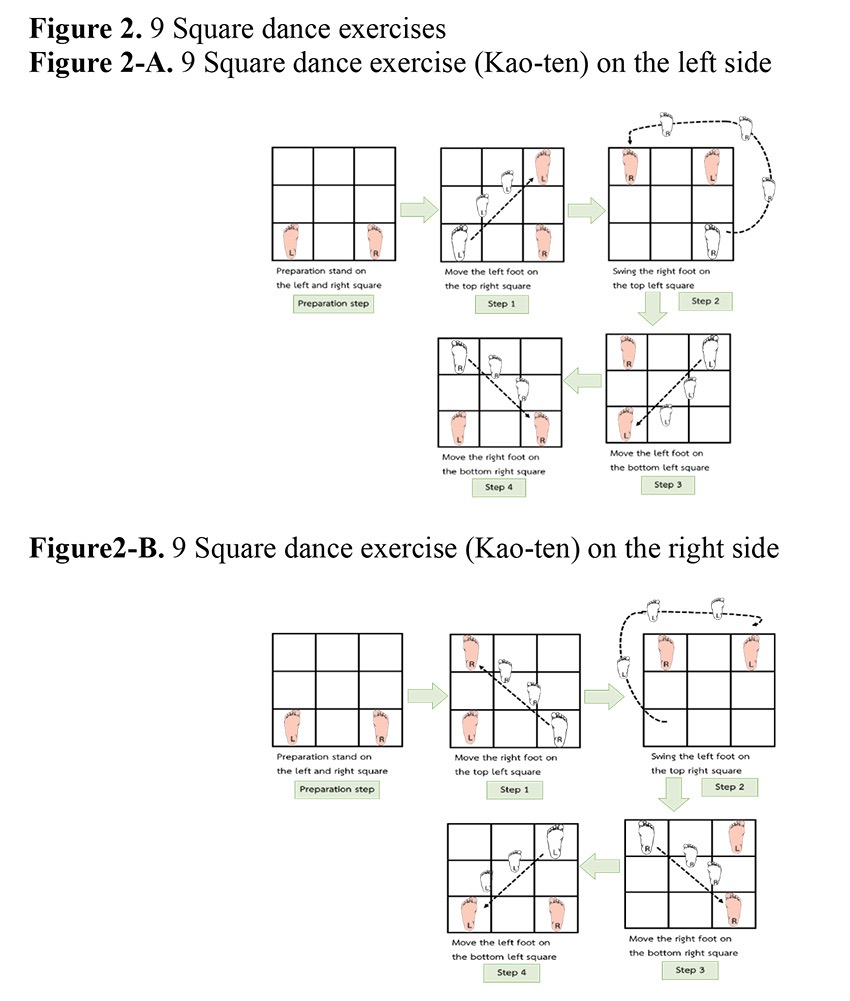Effects of Different Durations of 9-Square Dance Exercise Versus Treadmill Exercise on the Physical Fitness and Quality of Life of Healthy Volunteers: A Pilot Randomized Controlled Trial
DOI:
https://doi.org/10.33192/Smj.2022.103Keywords:
9 square dance exercise, physical fitness, aerobic exercise, Thai traditional exercise, quality of lifeAbstract
Objective: To evaluate the impact of 9-square dance exercise (9SDE) on physical fitness and quality of life compared to traditional treadmill exercise (TME).
Materials and Methods: In total, 33 healthy volunteers (10 men, 23 women) were recruited and randomly assigned into three groups: 9 square dance exercise for 8 minutes (9SDE-8), 9 square dance exercise for 30 minutes (9SDE-30), or treadmill exercise (TME). Exercises were done three times a week for 12 weeks and physical fitness tests were performed for all the groups at weeks 0, 6, and 12. Participants were assessed using the European Quality of Life Measure 5 Domains and 5 Levels questionnaire (EQ-5D-5L).
Results: Significant improvements in cardiorespiratory endurance, leg strength, and flexibility were demonstrated in the 9SDE-30 group (p<0.05). There was no significant difference in physical fitness between the 9SDE-30 and TME groups. The 9SDE-8 group showed a significant improvement in utility in the EQ-5D-5L questionnaire (p<0.05), while the TME group showed a significant improvement in directly evaluated health status (p<0.05). 9SDE-30 and TME showed similar improvements in cardiorespiratory endurance and leg strength.
Conclusion: Considering its low-resource requirement and overall utility, coupled with its effectiveness in promoting cardiovascular fitness and leg strength, 9SDE represents a viable exercise alternative for those with limited time and resources.
References
Caspersen CJ, Powell KE, Christenson GM. Physical activity, exercise, and physical fitness: definitions and distinctions for health-related research. Public Health Rep. 1985;100(2):126-31.
Wilmore JH. Aerobic exercise and endurance: improving fitness for health benefits. Phys Sportsmed. 2003;31(5):45-51.
Garber CE, Blissmer B, Deschenes MR, Franklin BA, Lamonte MJ, Lee IM, et al. American College of Sports Medicine position stand. Quantity and quality of exercise for developing and maintaining cardiorespiratory, musculoskeletal, and neuromotor fitness in apparently healthy adults: guidance for prescribing exercise. Med Sci Sports Exerc. 2011;43(7):1334-59.
Evans WJ. Exercise training guidelines for the elderly. Med Sci Sports Exerc. 1999;31(1):12-7.
Berger BG, McInman A. Exercise and the quality of life. J Sport Exerc Psychol 2011:483-505.
Martin CK, Church TS, Thompson AM, Earnest CP, Blair SN. Exercise dose and quality of life: a randomized controlled trial. Arch Intern Med. 2009;169(3):269-78.
Department of Physical Education, Ministry of Tourism and Sports. Report on the results of the survey of people’s exercise or playing sports for the year 2020 [July 15, 2022]. Available from: https://www.dpe.go.th/manual-preview-432891791793
Ruddy KJ, Stan DL, Bhagra A, Jurisson M, Cheville AL. Alternative Exercise Traditions in Cancer Rehabilitation. Phys Med Rehabil Clin N Am. 2017;28(1):181-92.
Griadhi IPA, Adiatmika IPG, Tirtayasa IK. Traditional Lègong Dance Training Is Superior to Moderate Aerobic Training on Physical Fitness Improvement Among Young Girls. J Phys Act Health. 2021;18(7):826-31.
Kim SM, Park HJ, Min BJ, So WY. Effects of a Korean Traditional Dance Program on Health-related Fitness and Blood Lipid Profiles in Korean Elderly Females. Iran J Public Health. 2018;47(1):127-9.
Ayurved Thamrong School, Center of Applied Thai Traditional Medicine. 9-Square Step Exercise. In: Tawee Laohapand, Uapong Jaturatamrong, editors. Thai Traditional Medicine in the Faculty of Medicine Siriraj Hospital. 2nd ed. Bangkok: Supavanich Press, 2014.p.67-70.
Ketusinh O. Kao-Ta, Kao-Ten, Kao-Ma, Kao-Sung in exercise. In: Niyomporn B, et al, editor. Ouay Ketusinh innovation. Bangkok, Thaimitr Print, 1988.p.141-6.
Atipas S, Chongkolwatana C, Suwannutsiri T, Thongyai K, Henggrathock S, Akarasereenont P. Effect of Kao-Ta (9-Square Step Exercise) and Kao-Ten (9-Square Dance Exercise) on Balance Rehabilitation in Patients with Balance Disorders. Siriraj Med J. 2019;71(1):1-7.
Bonoy S. A Comparison of The Effect of Exercise Training by Treadmill and Eliptical Cross Trainer upon VO2max [Thesis]. Bangkok: Srinakharinwirot University; 2005.
Sport Science Bureau, Department of Physical Education, Ministry of Tourism and Sports. Physical fitness test and criteria for Thai people aged 19 - 59 years [June 18, 2020]. Available from: https://dl.parliament.go.th /handle/lirt/ 575780
Pattanaphesaj J. Health-related quality of life measure (EQ-5D-5L): measurement property testing and its preference-based score in Thai population [Dissertation]. Nakornpathom, Thailand: Mahidol University; 2014.
Shigematsu R, Okura T, Sakai T, Rantanen T. Square-stepping exercise versus strength and balance training for fall risk factors. Aging Clin Exp Res. 2008;20(1):19-24.
Ronnarithivichai C, Thaweeboon T, Petchpansri S, Sujijantararat R, Boonchan N, Kridiborworn C. The evaluation of physical fitness before and after 9-square-table aerobic exercise and rubber ring stretching of elders in the health promotion program for the elderly, Faculty of Nursing, Mahidol University. J Nurs Sci Vol. 2009;27(3):68-77.
Douka S, Zilidou VI, Lilou O, Manou V. Traditional Dance Improves the Physical Fitness and Well-Being of the Elderly. Front Aging Neurosci. 2019;11:75.
Eyigor S, Karapolat H, Durmaz B, Ibisoglu U, Cakir S. A randomized controlled trial of Turkish folklore dance on the physical performance, balance, depression and quality of life in older women. Arch Gerontol Geriatr. 2009;48(1):84-8.
Kaltsatou AC, Kouidi EI, Anifanti MA, Douka SI, Deligiannis AP. Functional and psychosocial effects of either a traditional dancing or a formal exercising training program in patients with chronic heart failure: a comparative randomized controlled study. Clin Rehabil. 2014;28(2):128-38.
Filippou F, Goulimaris D, Baxevanos S, Genti M. Adult attendance in Greek traditional dancing classes. Exercise Quality Lif. 2010;2(1):15-28.

Published
How to Cite
Issue
Section
License

This work is licensed under a Creative Commons Attribution-NonCommercial-NoDerivatives 4.0 International License.
Authors who publish with this journal agree to the following conditions:
Copyright Transfer
In submitting a manuscript, the authors acknowledge that the work will become the copyrighted property of Siriraj Medical Journal upon publication.
License
Articles are licensed under a Creative Commons Attribution-NonCommercial-NoDerivatives 4.0 International License (CC BY-NC-ND 4.0). This license allows for the sharing of the work for non-commercial purposes with proper attribution to the authors and the journal. However, it does not permit modifications or the creation of derivative works.
Sharing and Access
Authors are encouraged to share their article on their personal or institutional websites and through other non-commercial platforms. Doing so can increase readership and citations.














